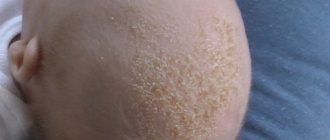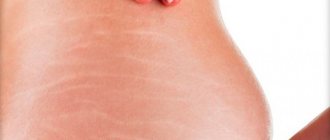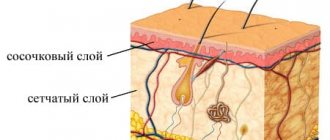Cracks on the feet are a partial violation of the integrity of the skin on the plantar part of the foot. They form more often on the heels; women are more susceptible to their occurrence. Deep cracks are unpleasant because they cause pain, take a long time to heal, and make walking and physical activity difficult. Like other injuries, they facilitate the penetration of pathogenic bacteria and fungi into the skin and are fraught with an infectious inflammatory process. Why do they arise?
Why are they formed?
Many people believe that only older people have cracks in their feet. Indeed, 25–30% of people over 40 have them. But they also occur in men, women younger than this age, and even in children.
The causes of cracks in the feet are a violation of the hydrolipid balance of the skin, a decrease in the production of collagen and elastin, and a decrease in the protective fat layer. Externally, this manifests itself in dryness, thickening, loss of elasticity, and firmness. Every day, the feet experience enormous pressure to support the body in a standing position, controlling balance when walking or running. With such a load, the skin inevitably stretches and expands. If it is dry and loses elasticity, then the likelihood of rupture when stretched under body weight will increase.
In addition to natural age-related changes, cracks in the skin of the feet are provoked by the following internal and external factors:
- wearing tight shoes;
- fungal infections, dermatitis;
- foot deformities, flat feet, heel spurs;
- poor hygiene, insufficient hydration or nutrition;
- skin contact with dry, hot air, salty sea or chlorinated pool water, ultraviolet rays;
- poor nutrition, leading to a deficiency of vitamins A, E, group B, and microelements important for skin health;
- endocrine disorders, including thyroid disease, diabetes;
- metabolic disorders;
- excess weight, which exposes the skin of the plantar part of the foot to excessive pressure and stretching;
- problems with blood circulation in the lower extremities, causing a lack of tissue nutrition;
- walking barefoot on hard surfaces (sand, stones, asphalt).
Cracks on the feet are a consequence of dry and thickened skin, or otherwise keratosis. Keratosis develops when keratinized or dead cells of the upper layer of skin do not have time to exfoliate and become layered on top of each other. In severe cases, the layer of thickened skin is 1–2 cm.
Causes of cracks between toes
The cause of the phenomenon in which the skin on the toes cracks and hurts can be due to exposure to both external and internal factors. In all cases where careful care does not produce results, a visit to the doctor is necessary.
Harmless cracks between the toes can be the beginning of fatal complications.
External
Among the external factors, the following are relevant:
- uncomfortable tight shoes made of synthetic materials;
- lack of hygiene and foot care;
- aggressive environmental influences during the warm season;
- trauma and microdamage to the skin of the feet due to walking barefoot;
- infection with a fungal infection.
After finding out the reasons why the skin between the toes bursts, it is necessary to take urgent measures to eliminate the problem. The earlier treatment measures begin, the greater the chance of completely curing the cracks.
To cope with foot fungus, independent efforts are not enough. A set of measures is prescribed by a dermatologist after the diagnosis has been clarified.
Fungal infections often occur after visiting a public bath or swimming pool. Using rubber shoes and treating the skin on your feet with antifungal ointments for preventive purposes will help avoid infection. Decreased reactivity increases the likelihood of fungal diseases.
Domestic
Malfunctions in the functioning of the body lead to the skin on the toes peeling and cracking.
In case of persistent relapses, it is necessary to exclude the following diseases:
- endocrine system (diabetes mellitus, pathological changes in the thyroid gland);
- digestive tract (gastritis);
- veins and arteries of the lower extremities.
The skin on the toes and soles becomes damaged (especially between the little toe and the 4th toe) if the body lacks important vitamins and minerals. A deficiency of retinol, tocopherol, and zinc has a negative effect on the condition of the skin.
The reason why the skin on your toes is cracking should be identified as soon as possible. The neglected process causes not only a violation of the integrity of the skin and its peeling, but also ulceration of the deeper layers. In severe cases, gangrene of the lower limb may develop.
What are the symptoms of cracked feet and heels?
In addition to the obvious symptom of large cracks surrounded by a thick layer of dry, cracked, flaky skin, cracks in the soles of the feet cause pain when walking. The pain is localized in the area of damage, has a burning character, and intensifies with pressure. Some experience psychological discomfort, since such wounds, especially if there are many of them, spoil the appearance of the feet.
Cracks in the heels vary in depth and length. They can be single or multiple, on one heel or simultaneously on both. Usually it all starts with the appearance of dryness, hardening, and thickening of the skin along the edge of the heel. These areas look like calluses and are yellow, dark brown, or gray-white in color. At first, small cracks are visible. But if they are not treated and you continue to put pressure on the heel, they will deepen and begin to bleed.
In diseases that lead to a decrease in blood flow to the feet, there is a high risk of infectious complications, inflammation, and the formation of long-term non-healing ulcers.
The mechanism of occurrence of pathology
External or internal factors lead to poor circulation and degenerative processes in the epidermis. The cells of the outer layer of skin die, resulting in peeling. Oxygen starvation leads to damage to the deep layers of the cover and the appearance of cracks.
Infectious infection with a fungal infection develops when the pathogen gets on the skin surface; the risk of the disease increases with a decrease in the body's immune response.
Increased sweating is a provoking factor for the growth of fungus. Maceration of the upper layers is one of the reasons for the violation of the integrity of the integument on the toes and on top of the foot. Damage to the epidermis can also be observed in the heel area and on the crook of all toes.
How to treat cracked feet?
To restore the skin, comprehensive treatment by a podologist is necessary, including:
- finding out the cause of cracks in the feet;
- proper care;
- selection of softening, nourishing ointments, foot creams for cracks;
- foot baths, paraffin therapy;
- keratolytic agents for removing dead skin;
- hardware pedicure.
Often cracks in the feet are the result of problems within the body. For example, endocrine, vascular or nervous disorders, lack of vitamins and minerals. It is important to establish and, if possible, eliminate the causes of cracks in the feet at the beginning of treatment. This will make it easier to restore healthy skin structure and help prevent the formation of new breaks in the future. If cracks in your feet appear regularly, you need to check your health.
One of the main treatments is hardware pedicure.
This is a safe method that:
- removes keratinized areas without injury;
- will thin out the hard edges of cracks;
- will accelerate tissue regeneration;
- will make the skin softer and more elastic.
It is recommended to perform the procedure regularly, once every 3 to 4 weeks.
To treat cracks in the feet and soles of the feet, paraffin therapy and foot baths are used as auxiliary means. Paraffin creates a film on the surface of the skin that provides protection and hydration. Baths help soften rough skin, but the possibility of their use and composition should be discussed with a doctor, since they are not always permitted.
To care for the skin, nourishing, moisturizing, and healing creams for cracks in the feet are applied several times a day. There are reviews of such products from different companies on the Internet, but you need to choose them on the advice of a doctor. In difficult cases, it is recommended to buy ointments and creams for cracks in the feet with a healing, anti-inflammatory, antiseptic, and regenerating effect. For infection, antibacterial or antifungal therapy is used depending on the type of pathogen.
If the layer of rough, dry skin is too thick, spreading over large areas of the foot, products with retinoids and keratolytics are used. They remove dead skin particles and accelerate its renewal.
The composition of keratolytic ointments includes:
- urea;
- salicylic, lactic acid;
- alpha hydroxy acids;
- fruit acids.
With deep cracks, you need to temporarily limit walking and playing sports to reduce the pressure and friction that is exerted on the injured area. If it is not possible to limit physical activity, orthoses, instep supports, insoles or patches are used. They help redistribute the load and protect the problem area.
Diagnostics
Itching, after which the skin cracks, and subsequently becomes wet and peeling, usually indicates a fungal infection.
To determine the cause of the pathological condition, consultation with specialists will be required:
- dermatologist;
- endocrinologist;
- vascular surgeon and phlebologist;
- gastroenterologist;
- nutritionist.
The following diagnostic examination methods will help confirm the diagnosis:
- microscopic examination of the epidermis;
- sowing the collected material to confirm mycosis;
- biochemical blood test for sugar content and determination of thyroid hormone activity;
- phlebography and ultrasound scanning of veins;
- Clinical urine analysis and according to Zimnitsky to determine the excretory function of the kidneys.
A comprehensive examination is necessary when the patient also has other symptoms of the disease.
Seeing a doctor is mandatory: only a specialist will be able to determine why the skin on your toes is cracking and prescribe the correct regimen of health measures.
How to warn?
If you have dry feet, the likelihood of cracks is high, so take care of their prevention.
What do we have to do?
- visit a podiatrist once a month for hardware treatment of the skin of the feet, removal of potentially dangerous areas - thickenings, corns, calluses where tears form;
- take care of a complete diet with sufficient vitamins and minerals;
- Every day after washing your feet before going to bed, apply moisturizing and nourishing creams to the skin of your feet;
- regularly massage your feet to improve blood circulation and metabolic processes;
- control weight;
- use special insoles, arch supports, orthopedic shoes if you have flat feet or other foot deformities;
- periodically treat feet with pumice stone and fine abrasive to remove dead cells.
If cracks appear, you should not try to eliminate them yourself, as this can worsen the situation and lead to complications. A competent approach is important here, which includes not only the treatment of cracks in the feet, but also an analysis of possible causes and recommendations for preventing relapse. If you encounter such a problem, contact a podiatrist. This is a specialist who specializes in treating diseases of the nails and skin of the feet.
13 1
Factors that cause cracks to appear
The skin on the arms and legs is highly sensitive, so it can withstand aggressive external influences with great difficulty. Deep, poorly healing cracks in the fingers, feet and palms are one of the most unpleasant problems that modern people face. Sores on the legs create discomfort while walking, which significantly impairs the quality of life. As for injuries on the upper extremities, they present primarily an aesthetic problem. In addition, the cracked areas of the epidermis hurt upon any contact with anything.
Vinikli nutrition - consult a doctor
To make an appointment for a consultation, call or fill out the return form:
(050) 301-99-26 (067) 446-11-79
Damn,
Your request has been successfully sent!
A call center specialist will contact you as soon as possible to clarify all the details.
The appearance of such a symptom should alert you, since it often turns out to be a signal of the presence of a serious systemic disease. For diagnostic purposes, it is recommended to visit a therapist or dermatologist. The doctor will examine the painful area, make a preliminary diagnosis and prescribe the necessary tests. The sooner you contact a specialist, the greater the chances of avoiding complications. In addition, you need to understand that poorly healing wounds are an open door for pathogens, and if left untreated, the risk of infection increases significantly.
There are several factors that cause cracks in the legs or arms.
- Hypovitaminosis. Increased dryness of the skin is caused by a lack of vitamins A and E. As a rule, a lack of nutrients occurs in the winter-spring period, when there is an acute shortage of plant foods in the diet.
- Exposure to cold. This factor affects the hands and palms to a greater extent, since they are the ones that are most exposed to frost in winter if you are in the habit of walking without gloves. The epidermis dries out and loses its initial elasticity, which causes partial tears.
- Inconvenient or poor quality shoes. In order to save money, people buy shoes and boots made of cheap materials, in which their feet sweat and are subject to severe friction. Such shoes interfere with blood circulation in the feet and injure the delicate skin. Wearing shoes that are too narrow or wide has a similar effect.
- Working with household chemicals without gloves. Aggressive components of detergents destroy epidermal cells, dehydrating them and depriving the skin of the hands of some collagen.
Prevention
Following these rules will help you avoid cracks:
- Everyday shoes should be comfortable and fit the size of your feet. It is important that it is made from natural material. In the summer, you will need to avoid contact with dust and dirt.
- Regular hygiene procedures to remove rough skin (you can use pumice stones, scrubs).
- Softening and nourishing the skin with the help of special products prevents the development of excessive dryness and the appearance of cracks.
- A balanced menu with a sufficient content of fat-soluble vitamins and microelements helps maintain the elasticity of the epidermis.
- It is necessary to avoid prolonged walking barefoot, as this contributes to the roughening of the skin of the feet and causes a violation of its integrity.
A preventive visit to the doctor will allow for early diagnosis of diseases and, if necessary, begin treatment.
The skin between the toes bursts in both adults and children for certain reasons. The appearance of a symptom cannot be ignored, as the problem may be a signal of serious changes in the body. A set of measures can completely restore the integrity and elasticity of the skin.









